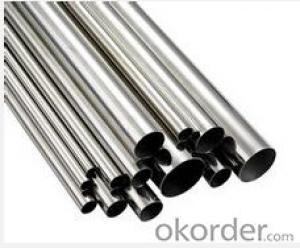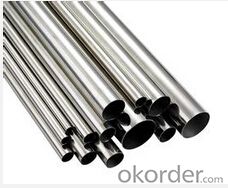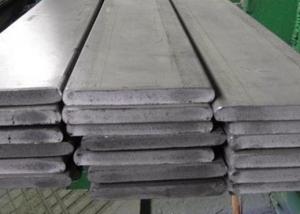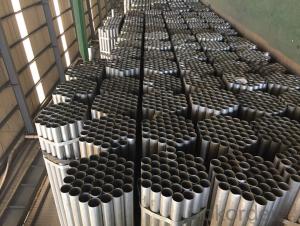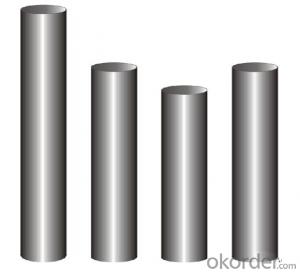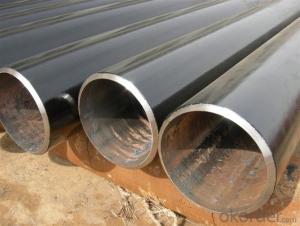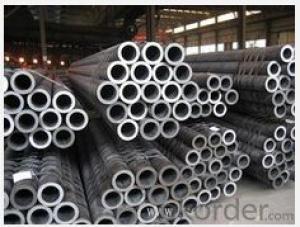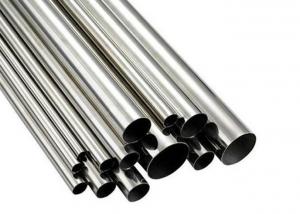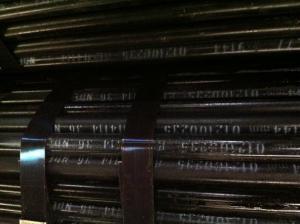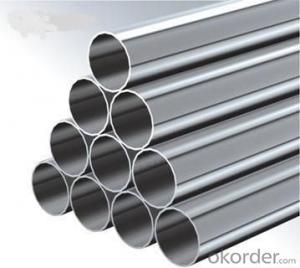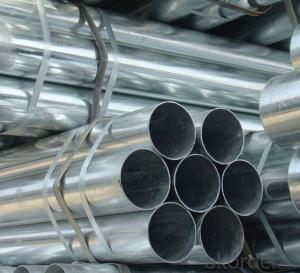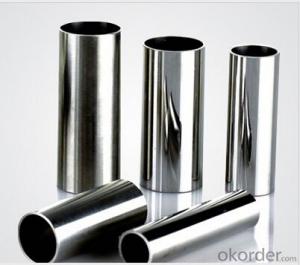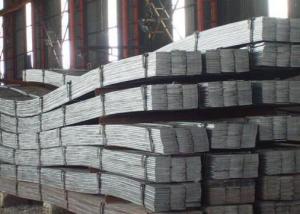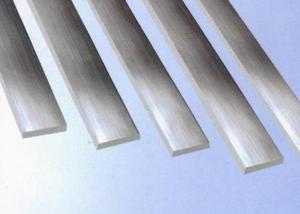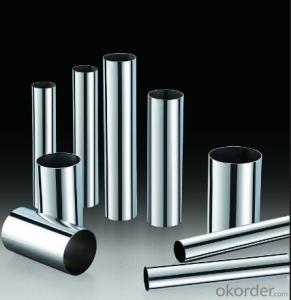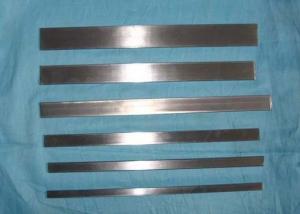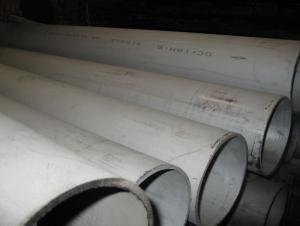Stainless seamless Steel Pipe polish round
- Loading Port:
- Qingdao
- Payment Terms:
- TT OR LC
- Min Order Qty:
- 1 m.t.
- Supply Capability:
- 5000 m.t./month
OKorder Service Pledge
Quality Product, Order Online Tracking, Timely Delivery
OKorder Financial Service
Credit Rating, Credit Services, Credit Purchasing
You Might Also Like
Specifications
material: stainless steel
size: various
packing: 1pc per plastic bag
sample time: within 7days
Material: stainless steel
Size: various
Packing: 1pc per plastic bag
Sample time: within 7days
HS Code: 7306400000
| Material | Stainless steel |
| Finish | Polish |
| Use | Frame |
| Size | Various, customized are welcome |
| Style | Round pipe, square pipe |
| Marking | according to your request |
| Payment | T/T, L/C |
| MOQ | 100PCS per Size |
| Capacity to produce | 300T per month |
| Packing details | 1pc per plastic bag |
| Delivery details | 30-35days after you confirm the order |
| Shipment | By sea, by air or DHL,UPS, Fedex |
| Port | Qingdao |
| Origin | China |
| Certificate | Mill certificate |
| Free sample time | in 7 days |
- Q: Stainless steel pipe welding interface leakage, how can we not leak?
- The gap between the group and the WPS should be corresponding, and the gap is too big or too small, which will lead to welding defects;
- Q: What is the maximum pressure stainless steel pipes can handle?
- The maximum pressure capacity of stainless steel pipes varies depending on several factors, including the grade of stainless steel, the pipe's wall thickness, and the specific application. Stainless steel pipes exhibit high resistance to pressure, making them suitable for diverse industrial uses. Different grades of stainless steel pipes, such as 304, 316, and 321, come with their own maximum pressure ratings. For example, grade 304 stainless steel pipes typically withstand pressures of up to 870 psi, while grade 316 stainless steel pipes can handle pressures up to 1,500 psi. It is important to consider the wall thickness of the pipe, as it significantly affects the maximum pressure capacity. Thicker-walled pipes generally tolerate higher pressures compared to thinner-walled pipes. Moreover, the specific application and operating conditions influence the maximum pressure capacity of stainless steel pipes. Factors like temperature, corrosive substances, and external forces must be taken into account to ensure the pipes can endure the intended pressure. To determine the maximum pressure capacity for a specific application, it is advisable to consult with a qualified engineer or refer to industry standards and guidelines, such as those provided by the American Society of Mechanical Engineers (ASME) or the International Organization for Standardization (ISO). These resources offer comprehensive information on pressure ratings and specifications for different grades and sizes of stainless steel pipes.
- Q: Are stainless steel pipes suitable for fertilizer industries?
- Yes, stainless steel pipes are suitable for fertilizer industries. Stainless steel is highly resistant to corrosion, which is important in industries where the pipes come into contact with corrosive substances such as fertilizers. Additionally, stainless steel pipes have high strength and durability, making them capable of withstanding the harsh conditions of fertilizer production. They also have a smooth inner surface, which prevents the buildup of sediments and impurities that could affect the quality of the fertilizer. Furthermore, stainless steel pipes are easy to clean and maintain, ensuring the hygiene and safety standards required by the fertilizer industry. Overall, stainless steel pipes are an excellent choice for fertilizer industries due to their corrosion resistance, strength, durability, and ease of maintenance.
- Q: Are stainless steel pipes suitable for breweries?
- Stainless steel pipes are highly suitable for breweries due to their numerous advantageous qualities. Firstly, their corrosion resistance is crucial in a brewery environment where they come into contact with liquids containing acids and other corrosive substances. This guarantees that the pipes will not rust or contaminate the beer with unwanted particles. Moreover, stainless steel pipes are highly hygienic. They are easy to clean and sanitize, which is essential in maintaining a high standard of cleanliness and preventing the growth of bacteria or other microorganisms that could spoil the beer. The smooth surface of stainless steel pipes also prevents the accumulation of residue or impurities, further enhancing the cleanliness of the brewing process. Additionally, stainless steel pipes exhibit excellent temperature resistance. They can withstand the high temperatures required for various brewing processes, such as boiling or sterilization, without deforming or losing their properties. This durability and heat resistance ensure that stainless steel pipes remain reliable and long-lasting, making them well-suited for breweries. In summary, stainless steel pipes possess a combination of corrosion resistance, hygienic properties, and temperature resistance that make them an ideal choice for breweries. They contribute to the production of high-quality and safe beer, providing a reliable and efficient infrastructure for the brewing process.
- Q: Can stainless steel pipes be used for gas or oil transportation?
- Yes, stainless steel pipes can be used for gas or oil transportation. Stainless steel is known for its high resistance to corrosion and can withstand high pressure and extreme temperatures, making it an ideal choice for transporting gas or oil safely and efficiently.
- Q: How do stainless steel pipes compare to copper pipes?
- Stainless steel pipes and copper pipes are both widely used in various applications, but they have distinct characteristics that set them apart. One of the main differences between stainless steel pipes and copper pipes is their resistance to corrosion. Stainless steel pipes have excellent corrosion resistance, making them suitable for environments with high humidity or exposure to chemicals. Copper pipes, on the other hand, are also corrosion-resistant but not to the same extent as stainless steel. They may corrode over time when exposed to certain chemicals or acidic conditions. Another factor to consider is cost. Copper pipes are generally more expensive than stainless steel pipes. However, copper is a highly efficient conductor of heat and electricity, making it a preferred choice for applications that require heat transfer, such as plumbing and HVAC systems. Stainless steel pipes are also good conductors but are generally less expensive than copper pipes, making them a cost-effective alternative in many cases. In terms of durability, stainless steel pipes are known for their strength and ability to withstand high pressures, making them suitable for industrial applications and underground installations. Copper pipes are also durable but may be more prone to damage in extreme conditions or when exposed to excessive pressure. Ease of installation is another factor to consider. Copper pipes are relatively easy to work with due to their malleability, which allows for easy bending and shaping. Stainless steel pipes, on the other hand, are typically harder and require specialized tools for cutting and bending. In summary, stainless steel pipes offer superior corrosion resistance, are cost-effective, and are ideal for high-pressure applications. Copper pipes, on the other hand, have excellent heat transfer properties and are more malleable, making them suitable for plumbing and HVAC systems. Ultimately, the choice between stainless steel and copper pipes depends on the specific requirements of the application and the budgetary constraints.
- Q: What are the common corrosion issues with stainless steel pipes?
- The common corrosion issues with stainless steel pipes include pitting corrosion, crevice corrosion, and stress corrosion cracking. Pitting corrosion occurs in localized areas, leading to the formation of small pits on the pipe surface. Crevice corrosion occurs in gaps or crevices, such as at pipe joints or under deposits, leading to localized corrosion. Stress corrosion cracking is a form of corrosion caused by a combination of tensile stress and a corrosive environment, resulting in cracking of the pipe.
- Q: How do you clean and maintain stainless steel pipes?
- To clean and maintain stainless steel pipes, you can follow these steps: 1. Start by wiping the surface of the pipes with a soft cloth or sponge to remove any loose dirt or dust. This will prevent scratching during the cleaning process. 2. Next, prepare a cleaning solution by mixing warm water with a mild detergent or dish soap. Avoid using abrasive cleaners or products containing chlorine, bleach, or ammonia, as these can damage the stainless steel. 3. Dip a soft cloth or sponge into the cleaning solution and gently scrub the pipes, following the grain of the stainless steel. This will help remove any stains or grime. 4. For tougher stains or grease buildup, you can use a non-abrasive cleaner specifically designed for stainless steel. Apply the cleaner to the affected area and scrub gently with a soft cloth or sponge. 5. Rinse the pipes thoroughly with clean water to remove any soap residue. 6. Dry the pipes completely using a soft cloth or towel. This will prevent water spots or streaks from forming. 7. To maintain the shine and luster of stainless steel pipes, you can use a stainless steel polish or a homemade solution of vinegar and olive oil. Apply a small amount to a soft cloth and buff the pipes in circular motions. 8. In areas with high humidity or exposure to harsh chemicals, it may be necessary to clean and maintain the stainless steel pipes more frequently. Regular cleaning will help prevent corrosion and maintain their appearance. Remember to always check the manufacturer's guidelines for specific cleaning instructions, as some stainless steel finishes may require different care methods.
- Q: Are stainless steel pipes suitable for mining industries?
- Stainless steel pipes are extensively utilized and deemed appropriate for the mining sector. The mining industry necessitates materials that can withstand harsh and corrosive environments, and stainless steel is widely recognized for its exceptional resistance to corrosion. This quality is especially significant in mining operations as pipes are constantly exposed to various chemicals, minerals, and water, which can hasten the corrosion procedure. Moreover, stainless steel pipes possess remarkable durability and can endure extreme temperatures, rendering them suitable for the demanding conditions encountered in mining activities. Furthermore, these pipes offer elevated strength and reliability, ensuring the secure and efficient transportation of fluids, gases, and slurries throughout the mining process. Consequently, stainless steel pipes are the preferred choice in the mining sector due to their corrosion resistance, durability, and strength, establishing them as a dependable and long-lasting alternative for mining operations.
- Q: What is the difference between nominal diameter and actual diameter in stainless steel pipes?
- The distinction between nominal diameter and actual diameter in stainless steel pipes is based on their respective definitions and practical applications. Nominal diameter, also referred to as nominal size, is the assigned label for a pipe based on its approximate internal diameter. It is an industry standard measurement used for communication and categorization of pipes. The nominal diameter is typically stated in inches or millimeters and is often rounded to the nearest whole number. For instance, a pipe labeled with a nominal diameter of 2 inches would generally have an internal diameter close to, but not exactly, 2 inches. On the contrary, actual diameter represents the precise measurement of the internal diameter of a stainless steel pipe. It is determined by physically measuring the inside diameter using tools such as calipers or a micrometer. The actual diameter provides an accurate measurement of the pipe's internal size, enabling precise calculations and proper fittings. The disparity between nominal diameter and actual diameter can vary depending on the manufacturing process and the specific tolerances of the stainless steel pipes. Generally, the actual diameter is slightly smaller than the nominal diameter due to factors like the thickness of the pipe's walls and manufacturing tolerances. This difference between the two measurements is known as the nominal wall thickness. Comprehending the dissimilarity between nominal diameter and actual diameter is crucial in various industries, particularly in plumbing, construction, and engineering. It ensures the appropriate selection, installation, and connection of pipes, preventing potential issues such as misalignment, leakage, or improper fittings. Therefore, it is essential to consider both the nominal diameter and actual diameter when working with stainless steel pipes to ensure the system's proper functioning and structural integrity.
Send your message to us
Stainless seamless Steel Pipe polish round
- Loading Port:
- Qingdao
- Payment Terms:
- TT OR LC
- Min Order Qty:
- 1 m.t.
- Supply Capability:
- 5000 m.t./month
OKorder Service Pledge
Quality Product, Order Online Tracking, Timely Delivery
OKorder Financial Service
Credit Rating, Credit Services, Credit Purchasing
Similar products
Hot products
Hot Searches
Related keywords
